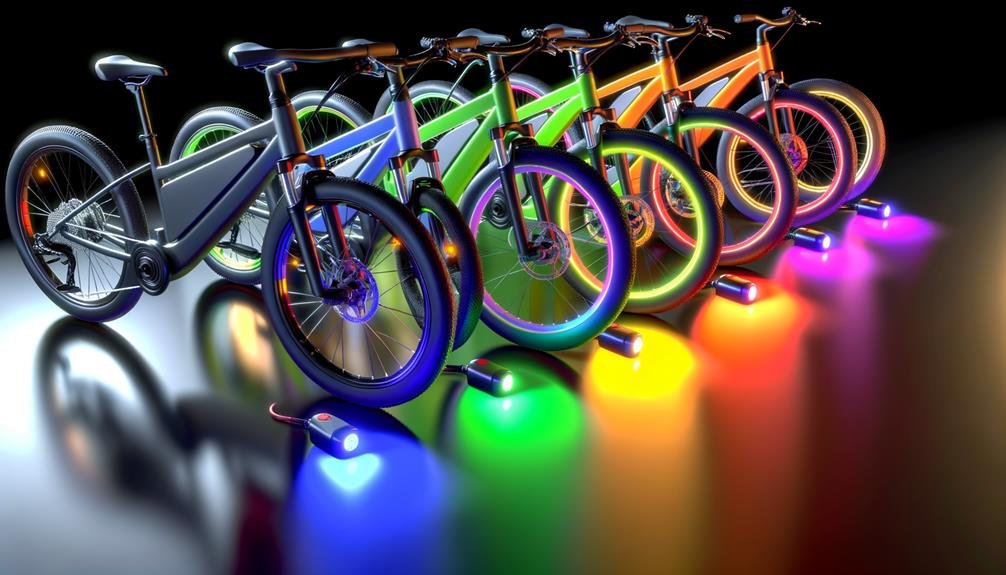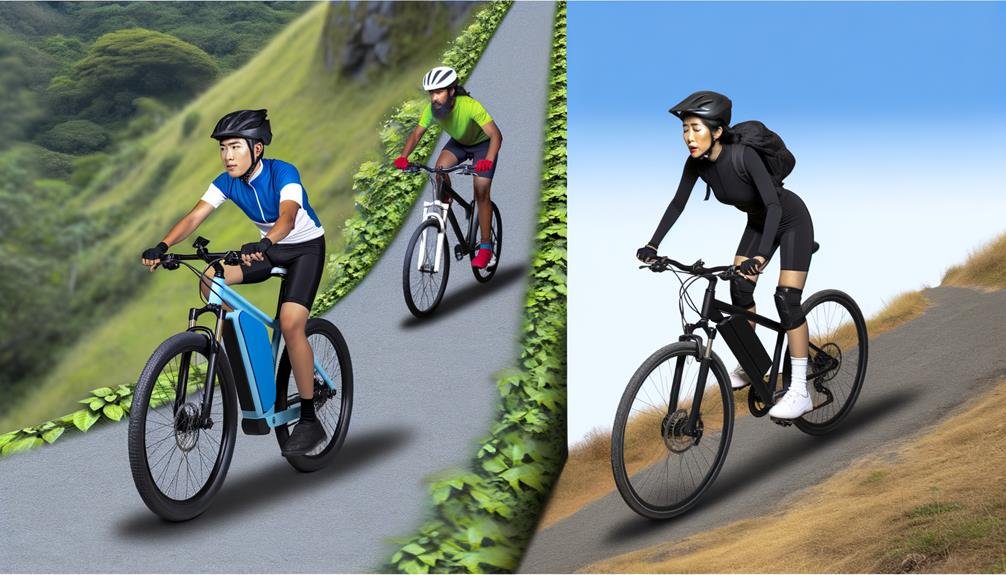Charles Miller is a veteran bike enthusiast with over 12 years of experience dealing with bikes as a mechanic. Despite immense love and expertise for...
One might think that an electric bike has the power to reach the moon, but let's ground ourselves in reality. We've seen electric bikes whizzing around, climbing steep inclines with ease, and often outpacing traditional bikes. So, just how powerful can these modern marvels be?
As we embark on this journey, we'll explore the true potential of electric bikes, unravel the mysteries behind their wattage, and discover how they can transform our daily commute. We'll also navigate the factors that influence their power – but hold onto your helmets, it's not as straightforward as you might think.
Key Takeaways
- Motor wattage determines the speed and hill-climbing capabilities of an electric bike.
- The range of an eBike depends on battery capacity, rider weight, terrain, and pedal assistance.
- Balancing human power with e-bike power enhances the riding experience.
- Choosing the right e-bike wattage depends on desired riding speed, terrain, and other factors.
Understanding Electric Bike Power
When it comes to understanding an eBike's power, it's crucial to note that the wattage of its motor, typically ranging from 250 to 750 watts, is the key determinant of its speed and hill-climbing capabilities.
As we delve into the intricacies of electric bike power, a careful analysis of the motor's wattage and the eBike battery's capacity helps us comprehend the performance potential of an E-Bike.
The motor controller comes into play, adjusting power levels based on a myriad of factors, including riding speed, terrain, aerodynamics, and wind. These elements dictate the required electric motor assistance, influencing the overall E-Bike power and, consequently, the range.
A higher voltage eBike battery is capable of delivering more power, enabling longer distances to be covered.
The range of an eBike, oscillating between 20 to over 100 miles, depends heavily on the battery capacity, rider weight, terrain, and level of pedal assistance. Power contribution from the eBike encapsulates the motor's power, duration of assistance, and the human power.
The choice of power level is highly personal, contingent on individual preferences, riding needs, and terrain considerations. We, as a community, should always strive to select the optimum power level to enjoy the full potential of our eBikes.
Human Power VS E-bike Power
Building on our understanding of eBike power, it's crucial to compare and contrast the influence of human power versus the power delivered by the eBike motor. With the Ultimate DIY Ebike guide as our compass, we can delve into this complex topic.
Choosing the right electric bike involves understanding the balance of human power vs e-bike power. It's about harnessing the power output of the electric bikes to complement our own effort.
Let's consider the following:
- E-bike manufacturers often label their bikes with the W motor power, ranging from a modest 250W to a whopping 1500W+. This determines the bike's assistance level; higher wattage equates to more power.
- The terrain and conditions we ride in also affect the power needed. Steep hills and strong headwinds require more power.
- Our own fitness levels and exertion also play a part. We contribute to the remaining power needed after the motor's assistance.
- Finally, the bike's range is an essential consideration, impacted by battery capacity, our weight, and level of pedal assistance.
Understanding these factors will help us feel more connected to our electric bicycle choice, making the experience more enjoyable.
Decoding E-bike Wattage Myths

Let's debunk some common myths surrounding e-bike wattage, as it's crucial to understand that the power of an electric bicycle isn't solely determined by its wattage. While decoding e-bike wattage myths, we must consider the role of hub motors, battery capacity, terrain, and more.
Firstly, the myth that higher wattage equals higher powered e-bikes must be addressed. Higher watts of power might offer faster speeds or better hill climbing capabilities, but the actual power output depends on factors like rider weight, terrain, and wind resistance.
Now, let's tackle the myth that more wattage always means better performance. It's not necessarily true. An e-bike with 500 watts may provide enough power for flat land cruising and moderate hill climbing. However, a higher wattage might be necessary for steep inclines or heavy loads.
Finally, the myth that more wattage equals less range. While it's true that higher-powered motors consume more energy, efficient use of pedal assistance levels can help maintain a decent range.
In short, wattage is an important factor in e-bike performance but needs to be evaluated in conjunction with other factors, such as motor type, battery capacity, and individual riding conditions.
Factors Determining E-bike Power
Understanding the factors that determine an e-bike's power is crucial to making an informed decision about your e-bike purchase. Let's delve into these factors determining e-bike power.
- Propulsion Options: Hub and mid-drive motors provide different benefits regarding power delivery and weight distribution. Mid-drives typically generate higher power, especially for a 45 lb) rider, enhancing hill-climbing ability.
- Throttle Presence: The presence of a throttle in Class 2 and 3 eBikes impacts power control and acceleration. The more throttle, the higher the amount of power that the electric motor will deliver.
- eBike Classes and Riding Locations: Class 1 eBikes are pedal-assist only, with a maximum speed of 20 mph. With Class 3, power does an electric motor deliver up to 28 mph. Class 2 eBikes have a throttle that can power the bike up to 20 mph.
- Motor Wattage and Range: Motor wattage directly impacts high power performance and speed. Conversely, the range is influenced by battery capacity, rider weight, terrain, and pedal assistance levels.
Choosing the Right E-bike Wattage

In the realm of e-bikes, selecting the appropriate motor wattage is a critical decision that hinges on several factors, including desired riding speed, terrain, aerodynamics, rolling resistance, and even wind conditions. It's about how much power the rider would need to navigate different environments. For instance, a 250-watt motor would suffice for a leisurely ride on flat terrain, but for steep hills, a motor with a higher wattage is a better fit.
| Motor Wattage | Suitable Terrain |
|---|---|
| 250-350 W | City/commuting |
| 500-750 W | Long/off-road |
This table offers a great example of choosing the right e-bike wattage based on your projected use. It's clear that the more challenging your ride, the greater the need for a higher wattage motor.
The power contribution from the e-bike involves not only the motor but also the rider. A huge amount of power is required to propel the front wheel, especially in adverse conditions. Thus, understanding power calculation and ratings is essential. So, when it comes to selecting your e-bike, remember: the right wattage makes all the difference.
Frequently Asked Questions
What Is the Maximum Power for Electric Bike?
We've seen eBikes with motors up to 1,500 watts, offering impressive torque output, climbing capabilities, and efficiency. However, regulatory restrictions, power consumption, battery longevity, and safety measures are factors that limit the maximum power.
How Powerful Can an Ebike Be?
We've seen eBikes with up to 750W motors. These bikes' power, combined with electric propulsion and torque control, greatly enhance their efficiency. However, battery capacity and power regulations can limit their range and overall power.
How Fast Does a 5000w Electric Bike Go?
We've found that a 5000w electric bike can reach 40-50 mph, depending on terrain and rider weight. However, speed regulation and safety measures are crucial, as is maintaining battery efficiency and proper motor functionality.
How Fast Will a 1000w Electric Bike Go?
We've found a 1000W electric bike can hit speeds up to 28 mph. Factors like rider weight, terrain, and pedaling assistance can affect this. However, safety measures and legal restrictions must also be considered.
Conclusion
In wrapping up, we've debunked a few myths and shed light on e-bike power. Remember, it's not always 'the bigger, the better' when it comes to e-bike wattage. Factors like your riding conditions, speed, and local regulations play a significant role.
So, when choosing your e-bike, consider your personal needs and let them guide your decision. After all, knowledge is power, and in this case, it's electric!

Charles Miller is a veteran bike enthusiast with over 12 years of experience dealing with bikes as a mechanic. Despite immense love and expertise for his Tacoma, he rides his Trek Ebike more. Anytime you meet him, you’ll either hear him talking about Bikes, or writing about all things bikes and cars on this blog.
More Posts


